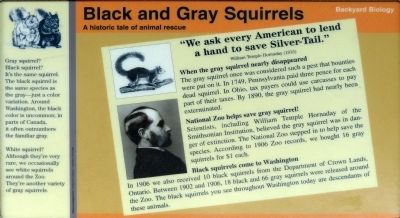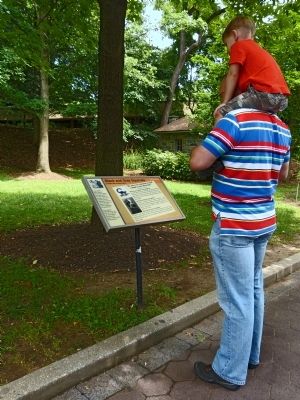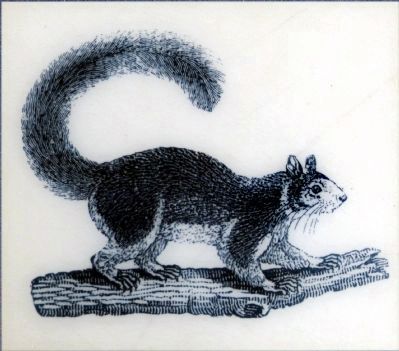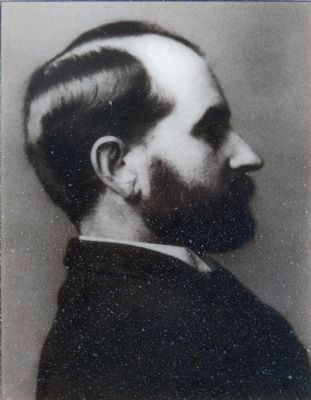Smithsonian National Zoo in Northwest Washington in Washington, District of Columbia — The American Northeast (Mid-Atlantic)
Black and Gray Squirrels
A historic tale of animal rescue
— Backyard Biology —
"We ask every American to lend a hand to save Silver-Tail" -- William Temple Hornaday (1913)
When the gray squirrel nearly disappeared
The gray squirrel once was considered such a pest that bounties were put on it. In 1749, Pennsylvania paid three pence for each dead squirrel. In Ohio, tax payers could use carcasses to pay part of their taxes. By 1890, the gray squirrel had nearly been exterminated.
National Zoo helps save gray squirrel!
Scientists, including William Temple Hornaday of the Smithsonian Institution, believed the gray squirrel was in danger of extinction. The National Zoo stepped in to help save the species. According to 1906 Zoo records, we bought 16 gray squirrels for $1 each.
Black Squirrels come to Washington
In 1906 we also received 10 black squirrels from the Department of Crown Lands, Ontario. Between 1902 and 1906, 18 black and 66 gray squirrels were released around the Zoo.The black squirrels you see throughout Washington today are descendents of these animals.
Erected by National Zoological Park.
Topics. This historical marker is listed in these topic lists: Animals • Environment. A significant historical year for this entry is 1749.
Location. Marker has been permanently removed. It was located near 38° 55.807′ N, 77° 3.276′ W. Marker was in Northwest Washington in Washington, District of Columbia. It was in Smithsonian National Zoo. Marker could be reached from Connecticut Avenue Northwest north of Hawthorne Street Northwest, on the right when traveling north. Marker is inside the front gate of the National Zoological Park on the right as you walk down the main path. Touch for map. Marker was at or near this postal address: 3001 Connecticut Avenue Northwest, Washington DC 20008, United States of America.
We have been informed that this sign or monument is no longer there and will not be replaced. This page is an archival view of what was.
Other nearby markers. At least 8 other markers are within walking distance of this location. Conservation Geography (within shouting distance of this marker); Fishing Cat (within shouting distance of this marker); Anup Joshi (within shouting distance of this marker); Saving Species Through Science (within shouting distance of this marker); Sloth Bear (within shouting distance of this marker); Redwood (within shouting distance of this marker); Max Kampelman (about 300 feet away, measured in a direct line); Optimism for the Oryx (about 300 feet away). Touch for a list and map of all markers in Northwest Washington.
Additional commentary.
1. Hornaday on the Gray Squirrel
William Temple Hornaday in his book Our Vanishing Wildlife reflected on the gray squirrel:
The Gray Squirrel. - The gray squirrel is in danger of extermination. Although it is our most beautiful and companionable small wild animal, and really unfit for food, Americans have strangely elected to class it as "game," and shoot it to death, to eat! And this in stall-fed America, in the twentieth century! Americans are the only white people in the world who eat squirrels. It would be just as reasonable, and no more barbarous, to kill domestic cats and eat them. Their flesh would taste quite as good as squirrel flesh and some of them would afford quite as good "sport."
Every intelligent person knows that in the United States the deadly shot-gun is rapidly exterminating every bird and every small mammal that is classed as "game," and which legally may be killed, even during two months of the twelve. The market gunners slaughter ducks, grouse, shore birds and rabbits as if we were all starving.
The beautiful gray squirrel has clung to life in a few of our forests and wood-lots, long after most other wild mammals have disappeared; but throughout at least ninety-five per cent of its original area, it is now extinct. During the past thirty years I have roamed the woods
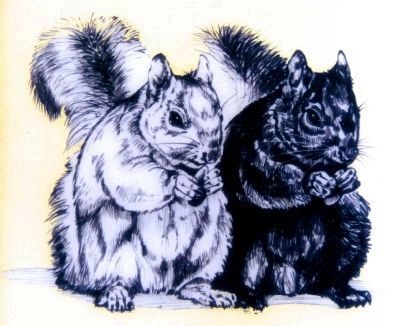
Photographed By Allen C. Browne, August 17, 2013
3. Black and Gray Squirrels
Gray Squirrel?
Black Squirrel?
Its the same Squirrel. The black squirrel is the same species as the gray -- just a color variation. Around Washington, the black color is common; in parts of Canada it often outnumbers the familiar gray.
White Squirrel?
Although they're very rare, we occasionally see white squirrels around the Zoo. They're another variety of gray squirrels.Close-up of illustration on marker
Black Squirrel?
Its the same Squirrel. The black squirrel is the same species as the gray -- just a color variation. Around Washington, the black color is common; in parts of Canada it often outnumbers the familiar gray.
White Squirrel?
Although they're very rare, we occasionally see white squirrels around the Zoo. They're another variety of gray squirrels.
Except over a very small total area, the gray squirrel is already gone from the wild fauna of New York State!
Do the well-fed people of America wish to have this beautiful animal entirely exterminated? Do they wish the woods' to become wholly lifeless? Or, do they desire to bring back some of the wild creatures, and keep them for their children to enjoy?
There is no wild mammal that responds to protection more quickly than the gray squirrel. In two years' time, wild specimens that are set free in city parks learn that they are safe from harm and become almost fearless. They take food from the hands of visitors, and climb into their arms. One of the most pleasing sights of the Zoological Park is the enjoyment of visitors, young and old, in "petting" our wild gray squirrels.
We ask the Boy Scouts of America to bring back this animal to each state where it belongs, by securing for it from legislatures and governors the perpetual closed seasons that it imperatively needs. It is not much to ask. This can be done by writing to members of the legislatures and requesting a suitable law. Such a request will be both right and reasonable; and three states have already granted it.
The gray squirrel is naturally the children's closest wild-animal friend. Surely every farmer boy would like to have colonies of gray squirrels around him, to keep him company, and furnish him with entertainment. A wood-lot without squirrels and chipmunks is indeed a lifeless place. For $20 anyone can restock any bit of woods with the most companionable and most beautiful tree-dweller that nature has given us. The question now is, which will you choose-a gray squirrel colony to every farm, or lifeless desolation?
We ask every American to lend a hand to save Silver-Tail.
— Submitted August 18, 2013, by Allen C. Browne of Silver Spring, Maryland.
Additional keywords. 🐿️
Credits. This page was last revised on March 14, 2023. It was originally submitted on August 18, 2013, by Allen C. Browne of Silver Spring, Maryland. This page has been viewed 607 times since then and 7 times this year. Last updated on May 6, 2018, by Devry Becker Jones of Washington, District of Columbia. Photos: 1, 2, 3, 4, 5. submitted on August 18, 2013, by Allen C. Browne of Silver Spring, Maryland. • Bill Pfingsten was the editor who published this page.
